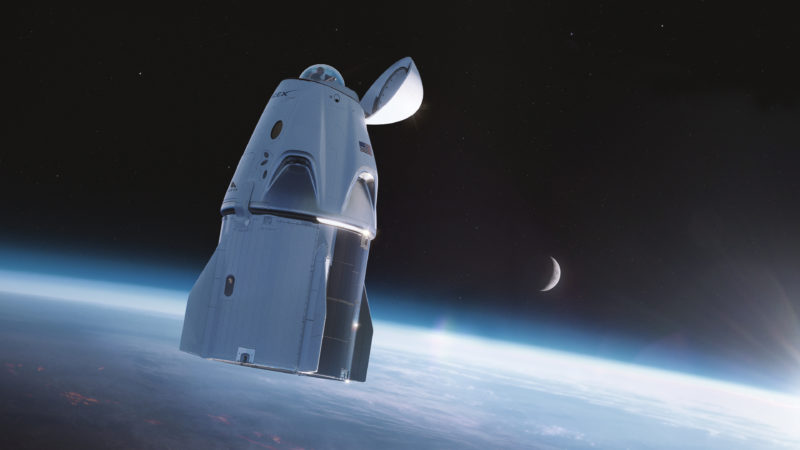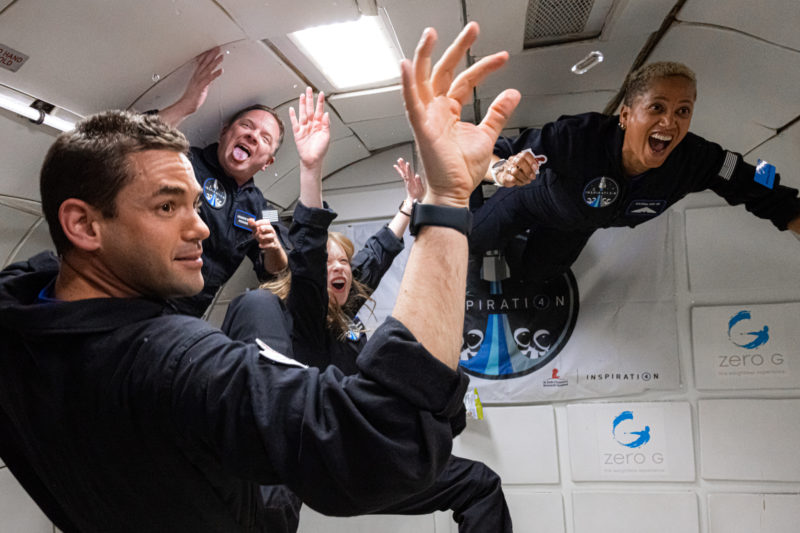
Favorable weather is expected for Wednesday night’s much-anticipated launch of Dragon Resilience and the Inspiration4 crew, touted as the first “all-civilian” orbital spaceflight. Liftoff of the three-to-five-day mission—which features a twice-used Falcon 9 booster core and a reflown Crew Dragon vehicle—is targeted to occur from historic Pad 39A at the Kennedy Space Center (KSC) in Florida, no sooner than 8:02 p.m. EDT, at the start of a five-hour “window”.
Aboard Resilience for the Earth-circling flight are Shift4 Payments founder and billionaire Jared Isaacman, geologist and science communicator Sian Proctor, physician’s assistant and childhood bone cancer survivor Hayley Arceneaux and Air Force veteran and Lockheed Martin data engineer Chris Sembroski.
This will be the second orbital voyage for Resilience, which previously supported the 167-day Crew-1 mission to the International Space Station (ISS). Launched last 15 November, she ferried NASA astronauts Mike Hopkins, Victor Glover and Shannon Walker, together with Japan’s Soichi Noguchi, to the station for a 5.5-month tour of duty spanning Expeditions 64 and 65.

Early last February, Resilience broke Skylab 4’s 84-day endurance record for the longest single spaceflight by a U.S. crew-carrying vehicle. The mission also saw Glover become the most flight-experienced African-American astronaut and Walker serve the shortest-ever tenure for an ISS Commander.
Following a smooth return to Earth and splashdown in the Gulf of Mexico last 2 May, Resilience was rapidly reconfigured to fly Inspiration4. Her processing flow from splashdown to launch, if tonight’s liftoff goes ahead as planned, will be accomplished in just 136 days, a little more than half the 264 days it took to prepare her sister, Dragon Endeavour, between her Demo-2 and in-progress Crew-2 missions.

Interestingly, as a non-ISS mission, Inspiration4 also benefits from the installation of a dome-like “cupola” viewing port, installed beneath Resilience’s docking adapter, which should furnish Isaacman, Proctor, Arceneaux and Sembroski with spectacular views of the Home Planet and space.
“Dragon’s new cupola observation dome will be the largest contiguous space window ever flown,” SpaceX explained. “The three-layer observation dome, which was extensively tested and qualified for flight in six months, replaces the mechanism used on Dragon’s previous flight to dock to the International Space Station.”

Inspiration4 is bound for an orbit which will reach almost 360 miles (575 km) at apogee, inclined 51.6 degrees to the equator. That promises to make this mission the highest-orbiting human spaceflight since the last Hubble Space Telescope (HST) servicing flight, back in May 2009.
Indeed, only a handful of human space voyages—including nine Apollo lunar expeditions, seven shuttle flights and a pair of high-flying Gemini missions—have ever reached or exceeded this altitude. Interestingly, STS-48 in September 1991 reached the same altitude that Inspiration4 aims to achieve.

“Wish we’d pushed ’em to go higher,” quipped Isaacman in a pre-flight press conference, held near Pad 39A on Tuesday, adding that it made sense for Inspiration4 to aim for an altitude goal “outside our comfort zone”.
But Benji Reed, SpaceX’s head of crew mission management, noted that the target altitude was bound by performance and other supply-budget consumables, including such requirements as carbon dioxide removal and food. The need to cater for Micrometeoroid Orbital Debris (MMOD) impacts and radiation levels at higher altitudes also factored into mission planning for this flight.

Not only Resilience, but also the core stage of tonight’s Falcon 9 have prior flight experience. The booster, tailnumbered “B1062”, previously saw service to launch the fourth and fifth Block III Global Positioning System (GPS) satellites in November 2020 and more recently in June of this year.
Following her return from her second flight in June, B1062 was paired with a brand-new second stage and Dragon Resilience was installed at her tip, before the 230-foot-tall (70-meter) vehicle was rolled out to Pad 39A and raised to the vertical last Sunday.

On Monday, SpaceX conducted a customary Static Fire Test of the nine Merlin 1D+ first-stage engines at B1062’s base, the successful completion of which allowed it to announce Wednesday night for the opening launch attempt.
When one considers the enormous publicity surrounding Inspiration4, it remains quite remarkable that this mission has only existed in the public consciousness for a matter of months, ever since Isaacman paid for a 30-second commercial ad during the 2021 Super Bowl.

Early in February, SpaceX announced that Isaacman, one-time Space Camp graduate and later billionaire founder of Allentown, Penn.-based payments processing firm Shift4 Payments, would command Crew Dragon and donate the remaining three seats—each valued around the $50 million ballpark—“to individuals from the general public”. A qualified pilot, in 2009 Isaacman circumnavigated the globe in under 62 hours.
“I could have just invited a bunch of my pilot buddies to go, and we would have had a great time and come back and had a bunch of cocktails,” Isaacman told Time magazine last month. “Instead, we wanted to bring in everyday people and energize everyone else around the idea of opening up spaceflight to more and more of us.”

Three weeks after the announcement of Isaacman, childhood bone cancer survivor Arceneaux, who now serves as a physician’s assistant at St. Jude Children’s Research Hospital in Memphis, Tenn., was named as the second crew member. She will be the first person in history to travel into space with a prosthesis, having received an artificial left femur to replace a bone she lost to the disease at only ten years old.
And in late March, the Inspiration4 line-up was completed when a judging panel concluded in favor of entrepreneur Proctor and St. Jude’s fundraising donor Sembroski. Each crew member represents one of four mission “pillars”: Isaacman as “leadership”, Arceneaux “hope”, Proctor “prosperity” and Sembroski “generosity”.

Aged 29, Arceneaux will be the youngest U.S. citizen to achieve low-Earth orbit—surpassing America’s first woman in space, Sally Ride, who was 32 at the time of her historic STS-7 shuttle flight in June 1983—whilst Proctor is set to become the first Guam-born astronaut, the fourth African-American female spacefarer and the first black female to pilot an orbital mission.
The Inspiration4 team plans a range of activities during their multi-day adventure, much of which is geared toward Isaacman’s goal of raising $200 million for St. Jude Children’s Research Hospital.

Proctor will demonstrate art and poetry in space, whilst Sembroski intends to play the ukulele—“acoustics are pretty good in Dragon,” he joked—and Arceneaux will oversee a range of health monitoring experiments, taking ultrasound measurements and observing bodily fluid shifts in microgravity. Proctor also plans to “spin Hayley a bunch of times” inside Resilience’s cabin.
Over the next several months, the crew trained for Inspiration4 in multiple settings. “We’ve just been going supersonic,” said Isaacman of the pace of training. They cemented their team-building skills in May by climbing over 10,000 feet (3,000 meters) to Camp Muir on Mount Rainer in Washington State. It demanded a ten-hour hike, recalled Arceneaux, and a total of three days spent on Rainier’s isolated slopes.

Interestingly, Sembroski lived in the Seattle, Wash., area for more than a decade, with the bulk of Mount Rainier a constant backdrop to his daily experience, but had never ascended to Camp Muir. During the trek, Proctor composed an “Ode to Rainier”, in which she emphasized unison and camaraderie, through “pain and perseverance”, to achieve “crew cohesion” and a sense of oneness with the mountain.
By the end of August, the Inspiration4 team was putting the finishing touches on their arduous training regime, which also included centrifuge runs, classroom work and flights in simulated conditions of weightlessness. The crew also participated in a 30-hour simulation inside the Crew Dragon simulator, which gave them a feel for life in its cramped quarters and tested them as four individuals.

“We came out of the 30-hour sim,” joked Proctor, “and still wanted to go!” For his part, Sembroski compares Inspiration4 to “an extended camping trip” and noted that the Crew-1 astronauts gave them some valuable insights into privacy and living aboard the spacecraft for multiple days.
On 2 September, the Flight Readiness Review (FRR) formally cleared the Falcon 9, Dragon Resilience, ground and recovery assets and crew to go. Last Thursday, they wrapped up their final activities at SpaceX’s training facility in Hawthorne, Calif., then flew to KSC for launch.

Weather conditions for tonight’s opening launch attempt are expected to be around 80-percent favorable, deteriorating to 70 percent for Thursday night’s backup slot. “The Spaceport will be sandwiched between two tropical systems, with [Tropical Storm] Nicholas over Louisiana and a weak circulation northeast of the Bahamas,” noted the 45th Weather Squadron at Patrick Space Force Base in its Tuesday update.
“This will weaken the low-level flow along the Space Coast, but liftoff weather continues to look favorable. Depending on how far north the Bahama system’s influence extends, the ascent corridor could see elevated winds and precipitation.”

As such, the main concerns tonight are Flight Through Precipitation with coastal showers and a potential breach of the Anvil Cloud Rule, associated with inland storms. A scrub and postponement to Thursday is expected to see the Atlantic tropical storm move to the east of South Carolina, as Nicholas’ remnants approach the Florida Panhandle.
“This will change the overall weather pattern across Central Florida,” the 45th stressed, “making it southwesterly with convection closer to the east side of the peninsula.” Accordingly, Thursday is shadowed by a somewhat greater threat from winds and precipitation.






4 Comments
4 Pings & Trackbacks
Pingback:Inspiration4 Launches, Delivers First All-Civilian Crew to Orbit « AmericaSpace
Pingback:Inspiration4 Launches, Delivers First All-Civilian Crew to Orbit
Pingback:Dragon Resilience Primed for Wednesday Launch, As Inspiration4 Prepares to Inspire
Pingback:Inspiration4 Launches, Delivers First All-Civilian Crew to Orbit « AmericaSpace - Technology News